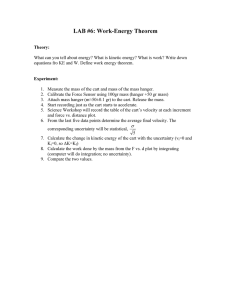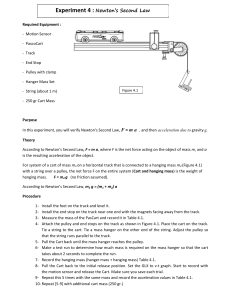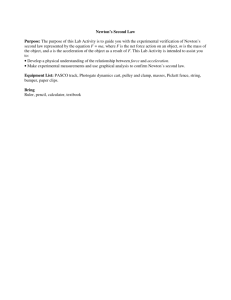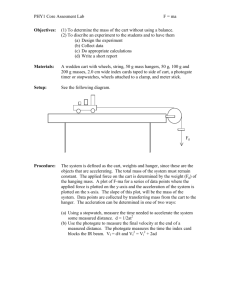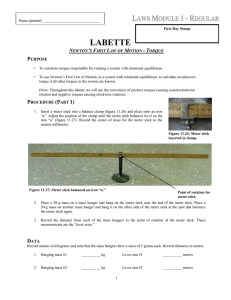PHYSICS LAB EXAM - La Salle University
advertisement
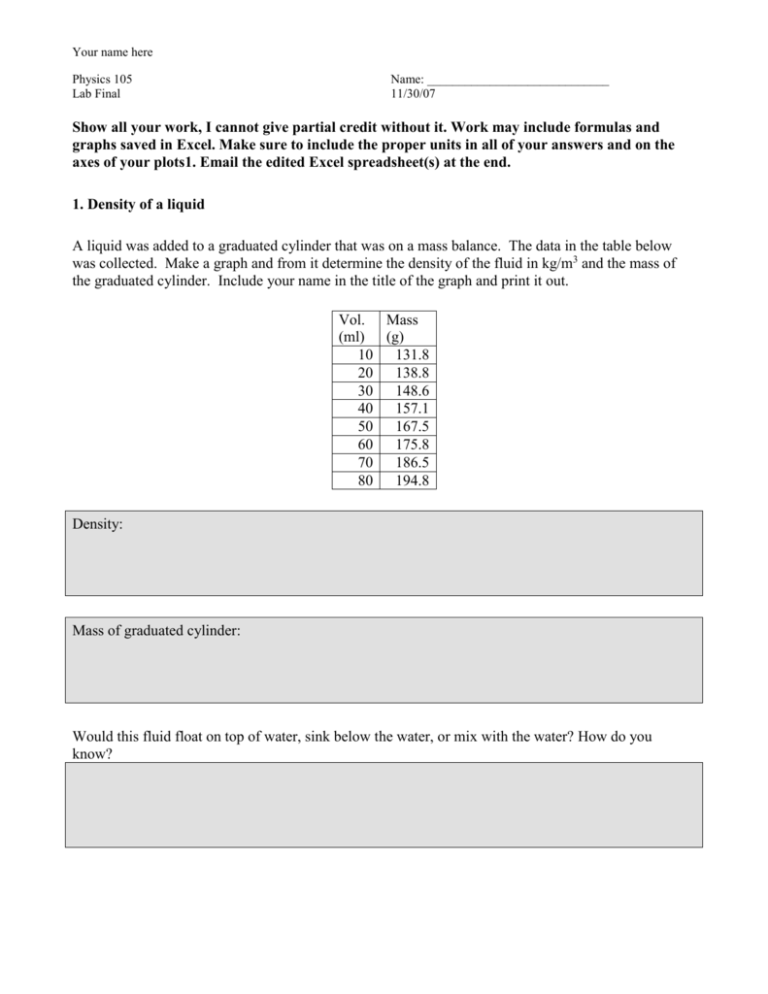
Your name here Physics 105 Lab Final Name: _____________________________ 11/30/07 Show all your work, I cannot give partial credit without it. Work may include formulas and graphs saved in Excel. Make sure to include the proper units in all of your answers and on the axes of your plots1. Email the edited Excel spreadsheet(s) at the end. 1. Density of a liquid A liquid was added to a graduated cylinder that was on a mass balance. The data in the table below was collected. Make a graph and from it determine the density of the fluid in kg/m3 and the mass of the graduated cylinder. Include your name in the title of the graph and print it out. Vol. Mass (ml) (g) 10 131.8 20 138.8 30 148.6 40 157.1 50 167.5 60 175.8 70 186.5 80 194.8 Density: Mass of graduated cylinder: Would this fluid float on top of water, sink below the water, or mix with the water? How do you know? Your name here 2. Energy analysis of Lab 6 data A 500-g block of mass was placed on a 125.5-g friction block; it was attached to a 50-g hanger with an additional 200 grams weight added by a string that passed over a pulley as shown in the figure below. The bottom of the hanger was 62 cm above the ground when it was released. The position versus time and velocity versus time data was collected using a Smart Pulley and can be found in the p105_f07_lab_final.xls. Use the equations below (from Lab 6) with the coefficient of friction k set to zero to solve for the ideal acceleration. Block Y comp. Nb - mbg = 0 Block X comp. Tb - µk Nb = mb ab Hanger Y comp. mhg - Th = mhah Ideal acceleration: Plot the data and extract the experimental acceleration. Include your name in the title of the graph and print it out. Experimental acceleration: Calculate the frictional force. Frictional force: Plot the mechanical energy versus time (two kinetic energies, one potential energy). Include your name in the title of the graph and print it out. Your name here Next include the work done against friction into your analysis. Plot mechanical energy plus work done against friction versus time. Include your name in the title of the graph and print it out. Compare the two graphs and relate them to the relevant physical principles. The hanger mass collides with the floor. Use the data provided to estimate the time for the collision. Provide your reasoning. Collision time: Next determine the impulse of the floor on the hanger mass. Impulse: 3. The Force Constant of a spring. The table below has data taken using a motion sensor. Masses were placed on a hanger, which hung from a spring positioned over a motion sensor. Position of Mass, bottom includes of hanger hanger (kg) (m) 0.050 0.793 0.100 0.772 0.150 0.734 0.200 0.725 0.250 0.690 0.300 0.651 0.350 0.643 Your name here Use a graph to determine the spring’s force constant and equilibrium position. Enter them below. Show work and/or explain. Include your name in the title of the graph and print it out. Spring constant ( ) Equilibrium position ( ) Work/Explanation: Repeat the above analysis taking into account the mass of the spring, which is 68 g. Spring constant ( ) Equilibrium position ( ) Work/Explanation: 4. Hydrostatic Weighing A subject weighing 175 pounds is asked to expel as much air from his/her lungs as possible and is then weighed under water. The result is 8.2 pounds. Assuming that all of the air is expelled, calculate the subject’s density. Using the physics involved discuss how the air remaining in the lungs (and elsewhere) affects the above density calculation. Your name here 5. Balancing Alice forgot to measure the mass of a meter stick used in the setup shown above. The 50.0-g hanger is positioned at 7.00 cm from the left edge; it hangs from a 17.0-g bracket and has a 50.0-g mass placed on it. The pivoting bracket also has a mass of 17.0 g and is positioned at 42.0 cm from the left edge. Help Alice by determining the mass of the meter stick. One of the forces on the meter stick is a normal force from the pivoting bracket; determine that as well. Show your work for each in the blue book. Mass of the meter stick ( ) Pivoting bracket normal force ( ) 6. Collision An experiment was performed with two carts and three blocks – each cart and each block has a mass of 500 g. The graph below shows the velocity of Cart 1 heading down a track and colliding with Cart 2, which initially had no velocity. After the collision, the two carts stuck together. Use the data displayed in the graph to determine which of the following scenarios pertains. A. 3 blocks in Cart 1, 0 blocks in Cart 2 B. 2 blocks in Cart 1, 1 block in Cart 2 C. 1 block in Cart 1, 2 blocks in Cart 2 D. 0 blocks in Cart 1, 3 blocks in Cart 2 Which set of masses? Explain your answer. Your name here Collision Data 0.7 0.6 Velocity (m/s) 0.5 0.4 0.3 0.2 0.1 0 2 2.2 2.4 2.6 Time (s) 2.8 3 3.2
